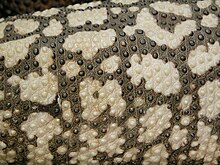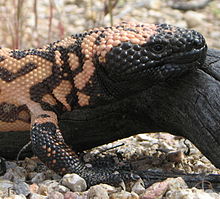Gila crustacean
| Gila crustacean | ||||||||||||
|---|---|---|---|---|---|---|---|---|---|---|---|---|

Gila crusty lizard ( Heloderma suspectum ) |
||||||||||||
| Systematics | ||||||||||||
|
||||||||||||
| Scientific name | ||||||||||||
| Heloderma suspectum | ||||||||||||
| Cope , 1869 |
The Gila crusty lizard ( Heloderma suspectum ), also called Gilatier , is one of the two recent representatives of the crusty lizard (Helodermatidae). The roughly 50 cm long, strongly built and conspicuously black and pink to red marked lizard lives in the arid regions of southwestern North America. It is diurnal and soil dwelling and feeds mainly on eggs, occasionally also on other small animals. For a long time it was regarded as the only poisonous lizard next to the closely related scorpion-crusty lizard ( Heloderma horridum ); According to recent findings, however, also have Komodo dragon ( Varanus komodoensis ), the eastern bearded dragon ( Pogona barbarta ) and perhaps many other species poison-producing tissue. On this basis, numerous reptiles are classified in the taxon Toxicofera . Nevertheless, compared to other lizards (e.g. the bearded dragon mentioned), the Gila crustal lizard is classified as highly toxic. The poison is mainly used for defense. The most noticeable symptoms after a bite are very severe pain, edema and poor circulation with a rapid drop in blood pressure. A Gila lizard bite can be fatal to humans; However, bite accidents are rare as the lizards live hidden and only bite after strong provocation.
The species was first described in 1869 by Edward Drinker Cope . The epithet suspectum he gave her because he suspected to external comparison with the already known Beaded Lizard (Engl. To suspect ) that the species is poisonous. The German name and the English term gila monster comes from the Gila River in Arizona .
features
The Gila crustacean reaches a total length of 35 to 50 cm, rarely 55 cm, with a head-torso length of 30 to 36 cm and an average of 600 g, maximum 1 kg weight. They are sturdy lizards, with blunt snouts and, like the scorpion-crusty lizard, small, knob-shaped skin bones ( osteoderms ). The head and tail of the males are proportionally slightly larger than those of the females, as these body parts play an important role in the ritualized commentary fights of the males (see section on reproduction). The animals are light pink to red and show a different black pattern between the subspecies. Young animals of both subspecies have 5 black transverse ligaments and 4-5 transverse ligaments on the tail. The thick, forked tongue is black.
Distribution, habitat and subspecies
Gila crustaceans are found in North America: in the United States in the Mojave Desert in the southernmost parts of Nevada , in southeast California , southwest Utah , Arizona and New Mexico , and in Mexico in the Sonoran Desert . There, the species comes from almost above sea level in the Sonora over 30 m to 1545 m in Arizona up to between 1180 m and 1950 m in New Mexico. It mainly inhabits desert areas, but also semi-deserts or sparse forests. The occurrence of the Gila crustacean depends heavily on whether there are suitable hiding places (between / under rocks or burrows that have already been built for rabbits and American bush rats ); therefore they are particularly common in rocky / stony regions.
There are currently 2 subspecies :
- H. s. cinctum Bogert & Martín des Campo , 1956 - Mojave Desert and from northwest Arizona to California, Nevada, and Utah. The subspecies retains the typical transverse ligament markings of young animals throughout its life.
- H. s. suspectum Cope , 1869 - nominate form , from Sinaloa (southern Sonora) to southern Arizona and southwestern New Mexico. In this subspecies the rather strict band pattern of the young animals dissolves into a more reticulate pattern; the expression of this characteristic is variable within the subspecies.
Way of life
The Gila crustacean is mainly ground-dwelling, but sometimes climbs up to 2.5 m high in desert undergrowth to plunder bird nests. In the cold winter months from November onwards, the species hibernates in its shelter, but basks next to its shelter on warmer days. They end the winter period in March. Gila lizards are most active between April and early June; At this time, the prey is particularly abundant, and the breeding season also falls within this window. Gila crustaceans are mainly active during the day, but when the days are cloudy and rainier and the nights are relatively warmer in summer, the species can also be more active at night.
Gila crustaceans move in range of 5.6-66.2 ha , the range of the individual specimens overlap considerably. Several individuals often use the same shelter. A shelter can be in use for years.
The species feeds on reptile and bird eggs as well as nesting mammals. In southwestern Utah, the animals leave their burrows in a typical "prowl" for 50 minutes and seek lambent for prey.
The breeding season of the Gila crustacean is in spring. The males fight each other in ritualized battles, probably to enforce a right to mate. They engage in a kind of wrestling match, often several times in a row; the males stand side by side and try to bend over the opponent and push him to the ground. The eggs are laid in July and August, but the young do not emerge until the middle of April next year; probably the eggs hibernate.
Poison
The Gila crustacean creates a toxin in transformed submaxillary glands . This is not injected through hollow teeth , as is the case with snakes , but runs along a notch in the teeth of the lower jaw. The lizard bites into the body of its victim and massages the poison in with chewing movements. It is then very difficult to detach a gila lizard from its victim. The lizard only bites in defense and warns with hissing and hissing beforehand.
Only a few cases of human sacrifice are known, as the lizard will only bite if you stimulate it to the utmost. 14 known cases of poisoning are reported in the specialist literature. While the amount of poison transmitted in a bite is not fatal to healthy adults, a bite can be life-threatening for people with heart failure without medical treatment. There is no antidote.
Symptoms of a bite include multiple small bite wounds, often broken teeth in the wounds, and swelling, edema, and blue discoloration of the affected limb. The pain spreads in a few minutes and persists for up to 24 hours. Concomitant symptoms are hypotension up to circulatory shock , sweating and dizziness . The toxin consists of the neurotoxin gilatoxin , which is almost identical to the Blarina toxin in the saliva of the American short-tailed shrews and other glycoproteins . One of these glycoproteins, the polypeptide exendin-4 or the synthetic variant exenatide , is used to treat type 2 diabetes mellitus . In addition, the enzymes hyaluronidase and kallikrein as well as serotonin are detected.
reception
The Gila-Krustenechse became popular through the novel “ Holes. The Secrets of Green Lake ”by Louis Sachar from 1998. In the book, the yellow-spotted lizard is stylized as a fearful animal, whose bite must inevitably lead to death. The lizard is exposed here as an inhabitant of a Texan inland desert, in the center of which a dry lake is said to lie in a karstified landscape. The animal is decisive for the progress of the novel and is therefore regularly the subject of investigation in contextual literature lessons.
swell
literature
- Daniel D. Beck: Heloderma suspectum ( Cope 1869). In: Eric R. Pianka, Dennis R. King, Ruth Allen King (Eds.): Varanoid Lizards of the World. Indiana University Press, Bloomington IN 2004, ISBN 0-253-34366-6 , pp. 528-534.
Individual evidence
- ↑ Heloderma suspectum in The Reptile Database ; Retrieved November 28, 2014.
- ^ Online Etymology Dictionary. Retrieved November 28, 2014 .
- ↑ Chris M. Gienger, Daniel D. Beck: Heads or tails? Sexual dimorphism in helodermatid lizards. In: Canadian Journal of Zoology. Vol. 85, No. 1, 2007, pp. 92-98, doi : 10.1139 / z06-198 .
- ↑ Heloderma suspectum in the endangered Red List species the IUCN 2006. Posted by: Hammerson, GA, Frost, DR Gadsden, H., 1996. Accessed November 28, 2014.
- ↑ a b c in Beck: Heloderma suspectum. 2004, source cited.
- ↑ "Approximately 14 human envenomations by Heloderma have been reported in the literature" - SD Aird: Nucleoside composition of Heloderma venoms. In: Comparative Biochemistry and Physiology Part B: Biochemistry and Molecular Biology. Volume 150, No. 2, 2008, p. 185.
- ↑ "Normally, the prognosis for envenomation by a Gila monster is favorable" PD Strimple, AJTomassoni, EJ Otten, D. Bahner: Report on envenomation by a Gila monster (Heloderma suspectum) with a discussion of venom apparatus, clinical findings, and treatment . In: Wilderness and Environmental Medicine. Volume 8, No. 2, 1997, p. 115.
- ↑ Franz-Xaver Reichl: Pocket Atlas of Toxicology. 2nd updated edition. Nikol, Hamburg 2008, ISBN 978-3-86820-005-8 , p. 253.
- ↑ Marc Boehmann, Claudia Pangh: Literature card index: "Holes". Verlag an der Ruhr, Mülheim an der Ruhr 2001, ISBN 978-3-86072-658-7 , p. 66.
Web links
- Heloderma suspectum in the endangered Red List species the IUCN 2006. Posted by: Hammerson, GA, Frost, DR Gadsden, H.., 1996
- Heloderma suspectum in The Reptile Database


